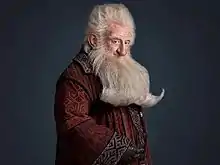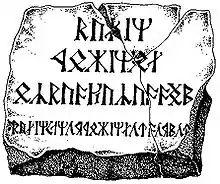Balin (Middle-earth)
Balin is a fictional character in J. R. R. Tolkien's legendarium. He is an important supporting character in The Hobbit, and is mentioned in The Fellowship of the Ring.
| Balin | |
|---|---|
| Tolkien character | |
| In-universe information | |
| Aliases | Lord of Moria[1] |
| Race | Dwarf |
| Book(s) | The Hobbit The Fellowship of the Ring Unfinished Tales |
Literature
Early life
Balin was born in Erebor, the son of Fundin. In the year Balin turned seven, Erebor was sacked by Smaug, and the Dwarves went into exile. During that period his younger brother Dwalin was born. Their father Fundin was killed in the Battle of Azanulbizar. Balin and his brother settled in the Blue Mountains with their surviving family. Balin and Dwalin were among those who set out with Thráin II in an attempt to return to Erebor, but they lost Thráin under the eaves of Mirkwood. After many days of fruitless searching, they returned to the Blue Mountains.[T 1]
The Hobbit
Balin was a dwarf member of Thorin Oakenshield's company of dwarves who travelled with Bilbo Baggins and Gandalf in the Quest of Erebor, on which the plot of The Hobbit centres. The second dwarf to arrive at Bilbo's house at the beginning of The Hobbit, preceded by his brother Dwalin, Balin was part of the company assembled by Thorin to kill the dragon Smaug and to retake the mountain kingdom of Erebor. Like his brother Dwalin, he played a viol. Other than Thorin, he was the only one who had been at the Mountain before the dragon came. He had been 7 years old while Thorin had been 24 on that day,[T 1] making him the second-eldest of the Dwarves.[T 2]
Tolkien describes Balin as "their look-out man": he spotted Bilbo approaching the Green Dragon Inn at Bywater,[T 2] saw the trolls' fire in the Trollshaws,[T 3] and was the first to see the elves in Mirkwood.[T 4] After they escaped the goblins in the Misty Mountains, Balin as look-out for the company failed to notice Bilbo (made invisible by wearing his magic ring), and after this incident he came to respect Bilbo's abilities as a burglar.[T 5] Balin served as the de facto spokesman for the party after the Elvenking captured the dwarves, as they did not at first realise that Thorin had been imprisoned with them as well.[T 6]
In the course of the Quest, Balin was the Dwarf who developed the closest friendship with Bilbo. He was the only one who volunteered to accompany Bilbo down the secret Erebor passage to Smaug.[T 7] Some years after the Quest, he and Gandalf visited Bilbo in Bag End, where Balin told of the mountain's glory restored in the years after the Battle of the Five Armies.[T 8]
The Lord of the Rings
In The Fellowship of the Ring, Gloin tells the Council of Elrond that Balin had left Erebor and ventured to reclaim Moria with a company of dwarves including Óin and Ori (two of his companions from the Quest of Erebor), and Flói, Frár, Lóni, and Náli. The fate of Balin's colony was uncertain, as no word had come from Moria in many years.[T 9] The Fellowship (which included Balin’s cousin Gimli) later happened upon Balin's tomb in the Chamber of Mazarbul, and learnt of his fate from the dwarves' book of records, the Book of Mazarbul. It told how Balin discovered Durin's Axe, and established a small colony, but it was overrun by orcs and Balin was killed by an orc archer in Dimrill Dale. Thus he died in the same place as his father, having been self-proclaimed Lord of Moria for less than five years.
Balin's tomb was inscribed "Balin Fundinul Uzbad Khazad-Dûmu", with smaller runes beneath giving the translation into English (as the representation of Tolkien’s invented language of Westron): "Balin, son of Fundin, Lord of Moria".[T 10]
Analysis
The Tolkien scholar John D. Rateliff writes that Balin is the only dwarf of Thorin's company whose name does not come directly from the Old Norse poem "Völuspá", part of the Poetic Edda.[2] The name appears in Le Morte d'Arthur, but Malory's Sir Balin is not nearly as likeable a character.[2]
The Tolkien scholar Tom Shippey notes that in the final scene of The Hobbit, Balin, Bilbo, and Gandalf discuss the connection between prophecy, individual action, and truth. Balin states that the new master of Dale is wise and popular, and the people "are making songs which say that in his day the rivers run with gold."[T 8] They agree that "after a fashion", the metaphors can indeed be true, that in Shippey's words "romance and reality are differences of presentation not of fact".[3]
The Company of the Ring stood silent beside the tomb of Balin. Frodo thought of Bilbo and his long friendship with the dwarf, and of Balin's visit to the Shire long ago. In that dusty chamber in the mountains it seemed a thousand years ago and on the other side of the world...
... in them were large iron-bound chests of wood. All had been broken and plundered; but beside the shattered lid of one there lay the remains of a book. It had been slashed and stabbed and partly burned, and it was so stained with black and other dark marks like old blood that little of it could be read...
At last Gandalf looked up. 'It seems to be a record of the fortunes of Balin's folk', he said. 'I guess that it began with their coming to Dimrill Dale nigh on thirty years ago...'
J. R. R. Tolkien, The Fellowship of the Ring, "The Bridge of Khazad-Dûm"
When Balin leaves, disastrously, to seek his fortune in Moria, "a shadow of disquiet" came over the Dwarves, as Glóin reports to the Council of Elrond.[T 9] Shippey writes that the metaphor of the shadow is ominous, and ambiguous: it could mean simple earthly discontent, or it could mean a spell from Mordor: "maybe Balin simultaneously fell [made his own choice] and was pushed [bewitched]."[3]
Tolkien expended enormous effort on constructing a facsimile Book of Mazarbul to resemble the burnt, torn volume abandoned at Balin's tomb, carefully staining and tearing the paper and burning in the burn-marks to make it as authentic as possible.[4] However, his publisher Allen & Unwin chose not to include his artwork in the first edition, prompting Tolkien to remark that without it the text at the start of "The Bridge of Khazad-Dûm" was "rather absurd".[T 11]
Adaptations

Don Messick voiced Balin in the 1977 animated version of The Hobbit.[6]
In Jackson's adaptation of The Hobbit, Balin is portrayed by Ken Stott as reluctant to go on the quest for old gold, whether or not the dragon had stolen it from his ancestors. As such, he is sympathetic to Bilbo, who appears quite unsuitable for the task he is being given.[7][8]
In the 2003 video game adaptation Balin is voiced by Victor Raider-Wexler.[9]
References
Primary
- This list identifies each item's location in Tolkien's writings.
- The Return of the King, Appendix A
- The Hobbit, ch. 1 "An Unexpected Party"
- The Hobbit, ch. 2 "Roast Mutton"
- The Hobbit, ch. 8 "Flies and Spiders"
- The Hobbit, ch. 6 "Out of the Frying-Pan into the Fire"
- The Hobbit, ch. 9 "Barrels Out of Bond"
- The Hobbit, ch. 12 "Inside Information"
- The Hobbit, ch. 19 "The Last Stage"
- The Fellowship of the Ring, book 2, ch. 2 "The Council of Elrond"
- The Fellowship of the Ring, book 2, ch. 5 "The Bridge of Khazad-dûm"
- Carpenter, Humphrey, ed. (1981), The Letters of J. R. R. Tolkien, Boston: Houghton Mifflin, #141 to Allen & Unwin, 9 October 1953, ISBN 978-0-395-31555-2
Secondary
- Fisher, Mark (1 March 2008). "Balin". The Encyclopedia of Arda. Retrieved 16 September 2012.
- Rateliff, John D. (2007). The History of the Hobbit: Part I. Mr. Baggins. Boston, New York: Houghton Mifflin. pp. 23–24. ISBN 978-0-618-96847-3.
- Shippey, Tom (2005) [1982]. The Road to Middle-Earth (3rd ed.). New York City: HarperCollins. pp. 104, 166–167. ISBN 978-0261102750.
- Holmes, John R. (2013) [2007]. "Art and Illustrations by Tolkien". In Drout, Michael D. C. (ed.). J.R.R. Tolkien Encyclopedia. Abingdon, England: Routledge. pp. 27–32. ISBN 978-0-415-86511-1.
- Riga, Frank P.; Thum, Maureen; Kollmann, Judith (2014). "From Children's Book to Epic Prequel: Peter Jackson's Transformation of Tolkien's 'The Hobbit'". Mythlore. 32 (2): Article 8.
- "Don Messick". Behind the Voice Actors. Retrieved 4 May 2020.
- Whitaker, Andrew (28 April 2014). "Scottish independence: Ken Stott backs 'Yes". The Scotsman.
- Sibley, Brian (2012). The Hobbit: An Unexpected Journey Official Movie Guide. Boston, Massachusetts: Houghton Mifflin Harcourt. pp. 84–85, 134]. ISBN 978-0-547-89930-5.
- "Victor Raider-Wexler". Behind the Voice Actors. Retrieved 21 May 2020.

.jpg.webp)